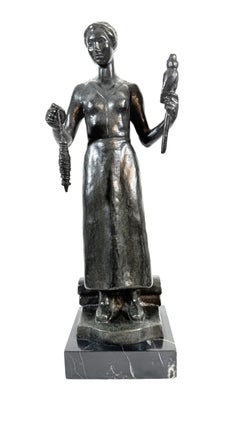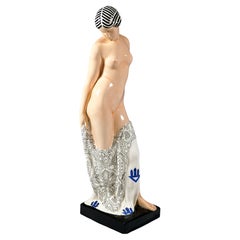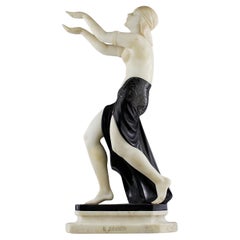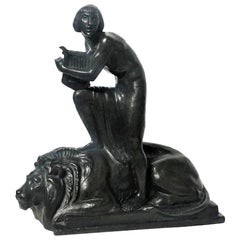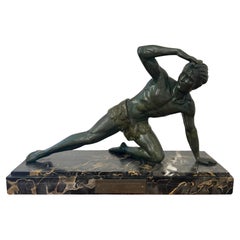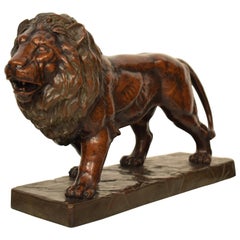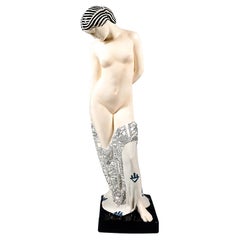Ernst Seger Furniture
to
3
1
4
4
2
1
Prof. Ernst Seger deutsche Art-Déco-Skulptur aus Bronze
By Ernst Seger
Located in Berlin, DE
PROF. ERNST SEGER
1868 Neurode - 1939 Berlin
STANDING SEAMSTRESS
Very rare bronze with exceptional figure representation.
Bronze, dark patinated, on a square marble base (H. 3 cm)....
Category
Early 20th Century Art Deco Ernst Seger Furniture
Materials
Bronze
Large Goldscheider Art Déco Figurine 'Helena', Allegory of Beauty, circa 1925
By Ernst Seger, Goldscheider Manufactory of Vienna
Located in Vienna, AT
Very large and rare Goldscheider Vienna ceramic figurine:
Art Déco execution of an Art Nouveau design around 1909: young woman as the personification of beauty, with hair tied at th...
Category
1920s Austrian Art Nouveau Vintage Ernst Seger Furniture
Materials
Ceramic
Ernst Seger, "Salomé" Sculpture, Black and White Marble, 1910 Art Deco
By Ernst Seger
Located in PARIS, FR
Absolutely stunning sculpture by Ernst Seger depicting Salomé, dancing before Herod. A dark black marble composes the floral motif base and dress. Circa 1910.
In very good condition...
Category
1910s German Art Deco Vintage Ernst Seger Furniture
Materials
Marble
Ernst Seger, David and Lion, German Art Deco Patinated Bronze Sculpture, c. 1920
By Ernst Seger
Located in New York, NY
Signed “E. Seger”.
Black patina.
Dimensions
Height: 8 inches (20cm)
Width: 7.5 inches (18.75cm)
Depth: 8.5 inches (21.25cm)
THE BIBLE STORY
Samuel 17:34-36
Originally, Saul would not allow David to fight Goliath (17:33). Saul’s reason was simply that Goliath would be stronger than David. David was young and he did not have the experience to fight such a capable enemy as Goliath. David was likely to die, and his death would benefit nobody.
Often people wrongly imagine that they are acting in faith (in other words, that they are trusting God). Really, they are acting in a foolish manner, as if the danger is not real. They are not trusting in God, but in their own thoughts, hopes and desires.
David’s reply to Saul shows us his attitudes. This reply explains clearly why David had offered to fight Goliath. In other words, it shows how David considered himself able to defeat Goliath.
Like many boys and young men in Israel, David had worked as a shepherd. That is, he looked after sheep. He was responsible to look after those sheep in every way. In particular, he had to protect them from wild animals.
Lions and bears are some of the fiercest large wild animals. They were common in Israel at the time of the Bible. They are much stronger than a man (see for example 1 Kings 13:24 and 2 Kings 2:24). Only the bravest and strongest men were able to kill a lion (Judges 14:5-6; 2 Samuel 23:20). However, David had killed both a lion and a bear. He had killed animals that were stronger than him.
David did not believe that the strongest man would win the fight. David had a close relationship with God; he was trusting God to rescue him (17:37). David was not pretending that there was no danger. However, God’s Holy Spirit was active in David’s life (16:13). By the power of his Holy Spirit, God had given David the faith (trust in God) to fight Goliath. Because David really was trusting God, there was no reason for him to be afraid of Goliath.
THE ARTIST
Ernst Seger (1865 1939), born in Neurode (Nowa Ruda, now Poland), studied sculpturing from 1884 at the Kunstschule in Breslau under Robert Härtel. From 1886 he worked in the Atelier of Christian Behrens, where he created the Eichendorff-Memorial for the Silezian City of Neisse. From 1893 to 1894 Seger stayed in Paris where he worked in the atelier of Auguste Rodin. However, Seger finally chose a ‘Jugenstill’ and a more ‘naturalistic’ or ‘Neuklassizismus’ style. His sculptures, modelled like the Greek antiques, were later greatly admired by the National Socialists.
At the end of 1894 Ernst Seger went back to Berlin, founded his own atelier and created the Kaiser Wilhelm I memorial for the Silesian City of Glatz. In 1897 Seger created the sculpture ‘Jugend’ (‘Youth’), which was displayed at the ‘Große Berliner Kunstausstellung’ in 1898, at the ‘Große Berliner Kunstausstellung’ in 1899, at the ‘Münchener Glaspalast Ausstellung’ in 1899 and at the ‘Münchener Glaspalast Ausstellung’ in 1908. As a sculptor Seger regarded this as his first relevant work, his breakthrough. A copy of the sculpture in bronze, 1.60 metres high, was placed in the ‘Scheitniger Park’ in Breslau (now Wroclaw). In 1898 Segers ‘Diana’, the Roman Goddess of the Hunt, the Moon and Childbirth, was unvealed in Park Szczytnicki, Breslau, Polen (earlier ‘Schneitniger Park’). Until 1945 the sculpture stayed in the Schneitniger Park, Breslau. This part of the park is still called ’Dianagarten’.
After the turn of the century the elegant female dancers and nudes by Seger gained great popularity. In 1905 Ernst Seger created -together with the sculptor Bernhard Sehring- the ‘Bismarck Brunnen’ (‘Bismarck Fountain’) in Breslau. This memorial-fountain (which still exists) represents the allegories ‘Kampf’ and ‘Sieg’ (‘Battle and Victory’). Seger’s ‘Verwundete Amazone’ (‘Wounded Amazon’), displayed at the Grosse Münchner Kunstausstellung in the Glaspalast in 1908, was placed in the garden of the ‘Kaufhauses Wertheim’ in Berlin. In the same year he was appointed as a professor. Seger’s marble sculpture ‘Kypris’, created in 1916, was placed in the Alten Nationalgalerie in Berlin. In 1925 the City of Berlin acquired his sculpture ‘Anbetung’ and placed it at the Johannaplatz. ‘Storchenbrunnen’ (‘Stork-fountain’), was placed in 1931 at the Adolf-Scheidt-Platz in Berlin. In 1935 the American newspaper publisher William Randolph Hearst bought Seger’s sleeping ‘Ganymede’.
During the Third Reich Ernst Seger was commissioned numerous Hitler busts...
Category
1920s German Art Deco Vintage Ernst Seger Furniture
Materials
Bronze
Related Items
Art Deco Male Sculpture, Spelter, Marble, France circa 1930
By Jean de Roncourt
Located in Regensburg, DE
Elegant Art Deco sculpture of an athletic scouting / watching male figure by Jean de Roncourt from France around 1930.
Very good original condition, greenish patinated Spelter / Zinc...
Category
1930s French Art Deco Vintage Ernst Seger Furniture
Materials
Marble, Bronze
Big German Art Deco Lion Sculpture in Ceramic, Terracotta Copper, 1930
Located in Berlin, DE
This very fine German Art Deco lion sculpture in ceramic, terracotta and a copper finish was made in the 1930s by EJM.
It is in a perfect antique condition with no chips and beautif...
Category
1930s German Art Deco Vintage Ernst Seger Furniture
Materials
Copper
$1,997
H 13.39 in W 21.66 in D 6.3 in
Life-Size Art Deco Patinated Bronze Greyhound Sculpture
Located in Forney, TX
A life size Art Deco patinated bronze figural dog sculpture, most likely Italian, early/mid-20th century.
Fine quality, exceptionally execute...
Category
Early 20th Century Art Deco Ernst Seger Furniture
Materials
Bronze
Late 19th Century Pair of Bronze Atlas Sculptures with Globe & Armillary Sphere
Located in Fredericksburg, VA
This pair of bronze sculptures of Atlas with Globe & Armillary Sphere are of high cast quality. Pairs have sold for over 700,000 Euro. Their condition is excellent for age and has ve...
Category
Early 20th Century Art Deco Ernst Seger Furniture
Materials
Bronze
$395,000
H 89 in W 22 in
French Art Deco Bronze Crucifix, 1920
By Peter Hartmann
Located in Saint-Amans-des-Cots, FR
French Art Deco Bronze Crucifix by Peter Hartmann, Switzerland, 1920s. Elegant and rare French Art Deco bronze crucifix by Swiss sculptor Peter Ha...
Category
1920s French Art Deco Vintage Ernst Seger Furniture
Materials
Bronze
Art Deco Ceramic Glazed Dancer Sculpture by Goldscheider, Vienna, 1930s
By Friedrich Goldscheider
Located in Ulm, DE
Beautiful Goldscheider Dancer Sculpture
Very detailed glazed ceramic sculpture in great condition!
Original Art Deco, Vienna (Austria) 1930s
Di...
Category
Early 20th Century Austrian Art Deco Ernst Seger Furniture
Materials
Ceramic
$3,407
H 11.42 in W 5.91 in D 4.34 in
Mid-Century Aldo Londi Bitossi Italian Art Pottery Lion Figurine Sculpture Italy
By Bitossi
Located in San Diego, CA
Wonderful Aldo Bitossi Italian art pottery lion figurine sculpture and dates from the 1960's. Marked on the bottom "Made in Italy". Color is great and the figurine is in excellent co...
Category
Mid-20th Century Italian Ernst Seger Furniture
Materials
Pottery
$360 Sale Price
20% Off
H 3.5 in W 6.25 in D 2 in
ERTE "LA DANSEUSE" 1986, BRONZE SCULPTURE
By Erte - Romain de Tirtoff
Located in Pembroke Pines, FL
"Femme de luxe" (Bronze)
by
Erte
Type: Sculpture
Media: Patina on Bronze
Dimensions: 13 3/4" High
Year Produced: 1986
Edition Size: 500 Numbered, 35 AP
Edition Number: 13/500
In Exce...
Category
1980s Art Deco Ernst Seger Furniture
Materials
Bronze
$4,399 Sale Price
20% Off
H 13.75 in W 6 in D 6 in
Antique Bronze Lion Sculpture 19th Century Brown Patinated Roaring Lion Statue
Located in Wembley, GB
Antique 19th Century Bronze Lion Sculpture, Naturalist Animalier Style
A powerful and finely cast antique bronze sculpture of a lion, dating to the 19th century, embodying the majesty and strength of the king of beasts. The lion is captured in a dynamic stride, with muscles tensed and mouth open in a fierce roar, a masterful portrayal of motion and authority.
Executed in dark brown patinated bronze, this piece demonstrates superb craftsmanship and anatomical precision, reflecting the European Animalier tradition that flourished in the 19th century. The deeply chased mane, sinewy body, and expressive face reveal both artistic sensitivity and technical mastery. The lion’s curved tail and forward stance lend a sense of fluid energy and balance.
At 31 cm in length, this sculpture commands attention without overwhelming the space — ideal for a mantel, study, or collector’s cabinet. Its naturalistic detailing and rich patina make it a timeless statement of power, courage, and refinement.
In very good antique condition, with gentle age patina and no visible repairs or losses.
Key Details
Material: Bronze with dark brown patina
Style/Period: 19th Century European Naturalist / Animalier
Subject: Lion, striding and roaring
Dimensions: Length 31 cm (approx.)
Condition: Very good, with natural age patina
Use: Collector’s display, interior décor, fine art sculpture
This sculpture exemplifies the grandeur of 19th-century Animalier art, when bronze lions symbolized power, bravery, and imperial dignity. A work of both artistry and strength, it enriches any setting - from classic interiors to contemporary design - with timeless elegance.
Antique Bronze Lion Sculpture, 19th Century Animalier Bronze, Naturalist Bronze Figure, French Animalier Art, Bronze Lion Statue...
Category
1880s French Art Deco Antique Ernst Seger Furniture
Materials
Gold Plate, Brass
$994 Sale Price
47% Off
H 5.91 in W 12.21 in D 4.73 in
Art Deco Pale Terracotta Ceramic Sculpture of Stylized Pouncing Tiger
Located in New York, NY
This stunning sculpture of an Art Deco Pouncing Tiger is realized in a pale terra-cotta glaze ceramic .It features a stylized Tiger on a stepped geometric base echoing the design of ...
Category
1930s French Art Deco Vintage Ernst Seger Furniture
Materials
Ceramic
$4,475
H 10.25 in W 17 in D 5 in
French Art Deco Period Lion Sculptures
Located in Austin, TX
Pair of sculptures from the Art Deco period in France. Each is sculpted into the shape of a lion, featuring one outstretched paw on a ball and supported by a base. These sculptures a...
Category
1940s French Art Deco Vintage Ernst Seger Furniture
Materials
Stone
Pair of 19th Century Limoges Monvoisin Porcelain Figurines
Located in Dallas, TX
Presenting a stunning pair of mid to late 19th century French Limoges Bisque porcelain figurines from circa 1870.
One is of a lady in period dress/attire cradling a Dove. All hand-painted and decorated to the finest quality. The base is marked with the makers initials “C.H.”. She is made of fine bisque porcelain in the Old Paris porcelain style.
The other is of a gentleman set...
Category
19th Century French Louis XVI Antique Ernst Seger Furniture
Materials
Porcelain, Paint
Previously Available Items
Large Goldscheider Art Déco Figurine 'Helena', Allegory of Beauty, circa 1920
By Ernst Seger, Goldscheider Manufactory of Vienna
Located in Vienna, AT
Very large and rare Goldscheider Vienna ceramic figurine:
Art Déco execution of an Art Nouveau design around 1909: young woman as the personification of beauty, with hair tied at the nape of the neck, head tilted to the side and looking down, covering the nakedness of her shapely body only at the legs with a large cloth...
Category
1920s Austrian Art Nouveau Vintage Ernst Seger Furniture
Materials
Ceramic
H 22.05 in W 7.09 in D 6.7 in
Large Goldscheider Art Déco Figurine 'Helena', Allegory of Beauty, circa 1920
By Ernst Seger, Goldscheider Manufactory of Vienna
Located in Vienna, AT
Very large and rare Goldscheider Vienna ceramic figurine:
Art Déco execution of an Art Nouveau design around 1909: young woman as the personification of beauty, with hair tied at th...
Category
1920s Austrian Art Nouveau Vintage Ernst Seger Furniture
Materials
Ceramic
H 22.05 in W 6.7 in D 6.7 in
Antique Alabaster & Marble Figural Table Lamp Ernst Seger, 1920s
By Ernst Seger
Located in London, GB
This is a beautiful museum quality antique Art Deco carved alabaster and marble figural table lamp, by the German sculptor Ernst Seger (1868-1939) the base bearing his engraved signa...
Category
1920s German Art Deco Vintage Ernst Seger Furniture
Materials
Alabaster, Marble
Ernst Seger, Girl Nude with Hair Band, c.1915-1925
By Ernst Seger
Located in Kingston, NY
Ernst Seger, (Madchenakt mit Haarband) Girl nude with hair band. Circa 1915-1925. Measures 20"H x 9.5"D x 14"W. The orange marble base is additional...
Category
Early 20th Century German Ernst Seger Furniture
Materials
Marble
Ernst Seger furniture for sale on 1stDibs.
Ernst Seger furniture are available for sale on 1stDibs. These distinctive items are frequently made of ceramic and are designed with extraordinary care. There are many options to choose from in our collection of Ernst Seger furniture, although beige editions of this piece are particularly popular. Many of the original furniture by Ernst Seger were created in the Art Nouveau style in europe during the 1920s. If you’re looking for additional options, many customers also consider furniture by Antal Bachruch, Josef Carl Klinkosch, and Bernhard Hoetger. Prices for Ernst Seger furniture can differ depending upon size, time period and other attributes — on 1stDibs, these items begin at $5,800 and can go as high as $8,661, while a piece like these, on average, fetch $8,650.
